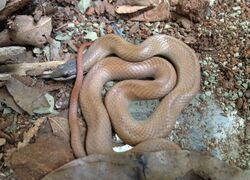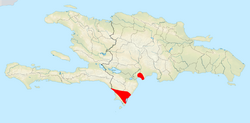Biology:Ialtris agyrtes
| Ialtris agyrtes | |
|---|---|

| |
| Scientific classification | |
| Domain: | Eukaryota |
| Kingdom: | Animalia |
| Phylum: | Chordata |
| Class: | Reptilia |
| Order: | Squamata |
| Suborder: | Serpentes |
| Family: | Colubridae |
| Genus: | Ialtris |
| Species: | I. agyrtes
|
| Binomial name | |
| Ialtris agyrtes Schwartz and Rossman, 1976
| |

| |
| Distribution of Ialtris agyrtes. Known range in red. | |
Ialtris agyrtes, also known as the Barahona red-headed racer or the Barreras fanged snake, is a rare species of snake in the subfamily Dipsadinae of the family Colubridae. This species endemic to the south-western Dominican Republic.[2]
Taxonomic history
This species was described in 1976 by Albert Schwartz and Douglas A. Rossman. The holotype (LSUM 28564) is an adult female from Barreras, Azua, Dominican Republic; and was captured by a native collector on 25 July 1969.[3]
Etymology
The name agyrtes has Greek origin, translating to "mountebank, cheat", and bears reference to the superficial resemblance of this species to Ialtris parishi.[3][4]
Morphology
A small species of Ialtris with a nearly patternless, brown to tan dorsum. A pale whitish supralabial line is present, extending from the tip of the snout to the base of the head and with darker brown superior margins. The venter is also patternless, nearly white, and grading posteriorly to pale orange.[3][5][4]
Distribution and habitat
This species is only known from three localities. Its range includes the southern foothills of Sierra de Bahoruco, in the Barahona peninsula; as well as the lower elevations of Sierra Martín Garcia. In these three locations the habitat is very similar, suggesting this species might be a specialist, inhabiting mid-elevation dry forests. The altitudinal distribution recorded is 20 to 541 m.[3][1][5]
It is a terrestrial species, with semi-fossorial habits. Specimen have been found under stones, and organic debris including the decaying rosettes of dead Agave which are particularly abundant in this species habitat.[5]
The diet of this snake is known to include blind-snakes (family Typhlopidae), and it has been hypothesized that this species could have a specialized, ophiophagous, diet of fossorial snakes. Other blind-snakes of the genus Mitophis (family Leptotyphlopidae), as well as snake-like lizards (Celestus agasepsoides) are known to be sympatric with I. agyrtes and could be part of its diet as well. Another species of the same genus, I. haetianus, is considered to be a specialist feeding on frogs of the genus Eleutherodactylus, along with their eggs. Since frogs are very abundant in the cloud forest habitat of I. haetianus, and blind-snakes are very abundant in the dry forest habitat of I. agyrtes, it could be considered that these to snakes occupy similar niches in distinct habitats.[5][1]
Conservation
This species is listed as Endangered (EN) by the IUCN Red List of Endangered Species, due to its limited distribution and the ongoing destruction of its habitat.[1]
Although this species is known to occur in at least two protected areas (Parque Nacional Jaragua and Parque Nacional Sierra Martín García), the particular dry forest habitat occupied by members of this species has received a lot of pressure resulting from heavy exploitation for charcoal production. Illegal agriculture, cattle grazing and wood harvesting also takes place in both national parks, and protection measures are poorly enforced.[1]
An invasive species, the Javan mongoose (Herpestes javanicus) has been suspected to represent a threat for I. agyrtes, but there is currently no evidence to support this claim. It is also possible that this has always been a rare species, and that populations are not declining, as it has never been reported to be abundant in past.[1]
The conservation of this species has received very little attention, and there are currently no conservation measures taking place.[1]
References
- ↑ 1.0 1.1 1.2 1.3 1.4 1.5 1.6 Inchaustegui, S.; Landestoy, M.; Henderson, R.W.; Hedges, B. (2016). "Ialtris agyrtes". IUCN Red List of Threatened Species 2016: e.T190585A115327959. https://www.iucnredlist.org/species/190585/115327959. Retrieved 12 April 2021.
- ↑ "Ialtris agyrtes". https://reptile-database.reptarium.cz/species.php?genus=Ialtris&species=agyrtes.
- ↑ 3.0 3.1 3.2 3.3 Schwartz, Albert (1976). "A review of the Hispaniolan colubrid snake genus Ialtris". Studies on the Fauna of Curaçao and other Caribbean Islands 50: 76–102. https://repository.naturalis.nl/pub/506221/SFAC1976050001003.pdf.
- ↑ 4.0 4.1 Powell, Robert; Henderson, Robert W. (1994). "Ialtris agyrtes Schwartz and Rossman" (in en). Catalogue of American Amphibians and Reptiles 591: 1-2. doi:10.15781/T2VQ2SF81. https://repositories.lib.utexas.edu/handle/2152/44647.
- ↑ 5.0 5.1 5.2 5.3 Schwartz, Albert (1991). Amphibians and reptiles of the West Indies : descriptions, distributions, and natural history. Robert W. Henderson. Gainesville: University of Florida Press. ISBN 0-585-19242-1. OCLC 44958544. https://www.worldcat.org/oclc/44958544.
Wikidata ☰ Q3147220 entry


